This was published 6 years ago
Manila walking tour, Philippines: The best way to see Manila for first-time visitors
If you want to get to know Manila, just put one foot in front of the other.
By Peter Barrett
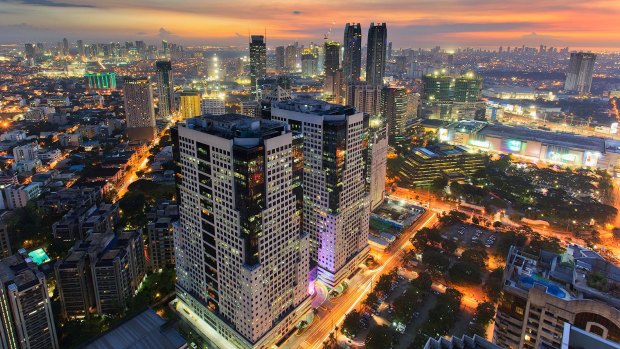
The bright lights of night-time Manila.
The traffic is so bad in the Filipino capital of Manila that locals watch half-hour television shows on how to beat it using cunning combinations of train, bus, taxi and the country's infamous open-ended, pimped-up jeeps, known as jeepneys. Some drivers even install karaoke machines to help kill time in gridlock.
So, it is no surprise that on the evening we arrive it takes us more than an hour to travel just seven kilometres from the airport to our hotel.
Manila is a city of contrasts, with citadels within citadels; wealthy business enclaves live cheek by jowl with sprawling districts of the urban poor.
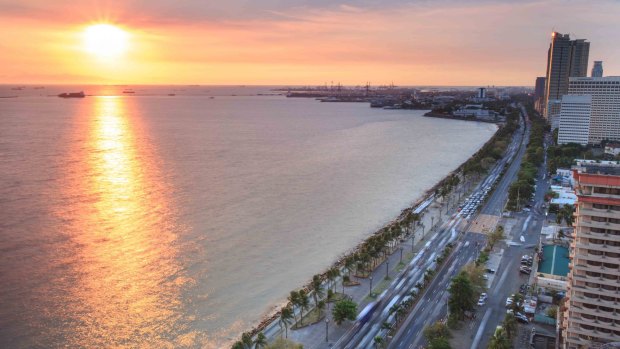
Manila sunset.
One morning we visit the American Cemetery, with endless rows of white gravestones set on green, immaculately kept grass; in the evening we slip past a shotgun-wielding security guard, through a hidden, 7-Eleven backdoor and into a heaving, international cocktail-bar world full of hip young things; another day I find myself wandering through a mall (a favourite Filipino pastime) and end up in a Jollibee restaurant (the Philippine equivalent of McDonalds), contemplating a plate of sweet ketchup spaghetti (a national dish).
How does a first-time visitor make sense of this place?
"Walk this way!" comes the loud, recurring refrain of performer and political activist Carlos Celdran, whose two-hour walking tour through Intramuros (a walled city within Manila built during Spanish rule) provides the answer. Celdran uses theatre, comedy and a healthy dose of pantomime to not only bring the story of the city alive, but to explain how history has conspired to create this unique, perplexing and fascinating country.
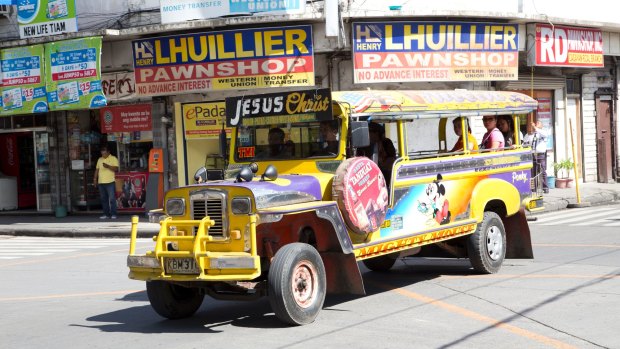
The iconic Manila Jeep.
For example, did you know that Manila was, according to Celdran, the worst-bombed Allied city in World War II, after Warsaw? Conservative estimates place civilian deaths at 100,000, with the irony being that it was the Americans who bombed the city to rout the occupying Japanese.
The US army left soon after, selling their old army jeeps to Filipinos for $1 each, and spawning the rise of those ubiquitous, privately owned jeepneys. The city's infrastructure never properly recovered. No wonder the traffic sucks.
Donning various hats and personas, Celdran reveals the key events in nearly 500 years of history: the Spanish arrived in Manila in 1571 to find 10,000 Muslims and bamboo huts; since they did not find any gold, the king of Spain allowed the Catholic church to run the show; igneous rock was not available so priests built churches out of crumbly volcanic rock, with floors made of granite imported from China; and, since locals outnumbered the friars, the priests learnt local dialects instead of imposing the Spanish language.
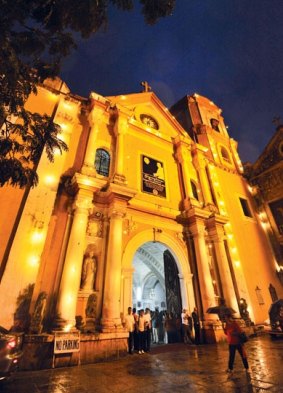
San Agustin Church.
"To be Filipino is to be Catholic. Theocracy!" Celdran's shout is loud enough to echo beyond Intramuros' walls.
In 1896, a young writer, Jose Rizal, dares to challenge the church's grip on politics and is executed for treason. He later becomes a national hero.
More hats, more history. This time, it is Uncle Sam. In 1898 America buys the Philippines from Spain for $US20 million, after the Spanish-American war. By the 1930s every child in the Philippines is learning English.
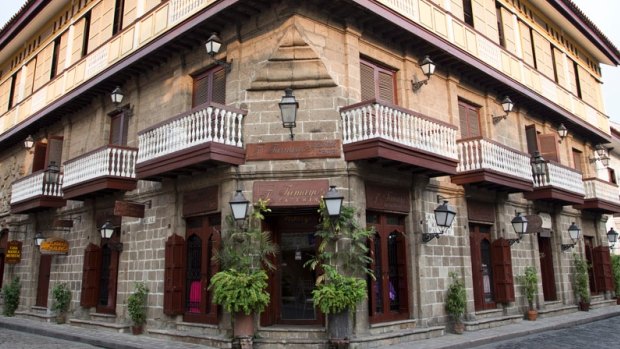
Casa Manila.
Back in my hotel I reflect on how call centres, globalisation and a tense political climate are making their own mark on the evolving Filipino identity. And, as my taxi crawls slowly through the traffic to the airport on my way home, I'm grateful for the few things I've learnt about this fascinating, perplexing country. But I also know there is so much more.
TRIP NOTES
MORE
traveller.com.au/philippines
explorephilippines.org
VISIT
Take a tour with Carlos Celdran through Intramuros, the "heart" of Manila, and immerse yourself in the complicated, emotion-charged history of this city of nearly 2 million people (phone +63 2 4844945 or see carlosceldranwalks.wordpress.com); then wander through the American Cemetery on McKinley Road, Fort Bonifacio, for some more perspective (see abmc.gov and search for "Manila"); cap the evening with an edgy street food tour through Manila's red light district, Poblacion, with Dee Jae Pa'este, aka the Starving Artist (book through tripkada.com or email him direct on deejae408@gmail.com).
FLY
Qantas, Cebu Pacific and Philippines Airlines (PAL) fly direct to Manila, which takes between seven and eight hours from Sydney or Melbourne. PAL flies frequently from Sydney, Melbourne, Brisbane and Darwin. See philippineairlines.com, qantas.com and cebupacificair.com.
STAY
The Philippines' densely populated capital has some diverse accommodation options. At the 500-room Dusit Thani Manila guests have easy walking access to several of the better shopping malls that locals seem to love. Rooms start from PHP5200 ($128), see dusit.com/dusitthani/manila/. For something more luxurious, the one-year-old Shangri-la at the Fort offers excellent facilities, including a mind-bogglingly large buffet breakfast and its own professional basketball court. Rooms start from PHP13,300, see shangri-la.com/manila/shangrilaatthefort/.
Peter Barrett travelled as a guest of Philippine Airlines and the Philippine Department of Tourism.
Sign up for the Traveller Deals newsletter
Get exclusive travel deals delivered straight to your inbox. Sign up now.